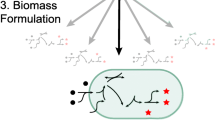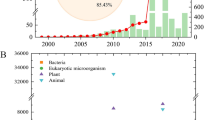Abstract
This chapter aims to review the machine learning algorithms and models applied for metabolic networks modeling. Metabolic models include structured repositories of information and prediction tools required to support metabolic engineering. This chapter introduces a background overview of various metabolic modeling approaches, including parametric and non-parametric models. In this chapter, we provide an overview of the various machine learning approaches used in metabolic modeling, with a focus on Hidden Markov Models (HMM), Probabilistic Context-Free Grammar (PCFG), and Bayesian Networks (BNs). We then present recent applications of machine learning in the context of metabolic network modeling concluding with a discussion on the limitations of current methods and challenges for future work.
Access this chapter
Tax calculation will be finalised at checkout
Purchases are for personal use only
Similar content being viewed by others
References
Helmy, M., Smith, D., Selvarajoo, K.: Systems biology approaches integrated with artificial intelligence for optimized metabolic engineering. Metab. Eng. Commun. 11, e00149 (2020)
Roy, S.S., Taguchi, Y.H.: Identification of genes associated with altered gene expression and m6A profiles during hypoxia using tensor decomposition based unsupervised feature extraction. Sci. Rep. 11(1), 8909 (2021)
Chen, Y., Nielsen, J.: Mathematical modeling of proteome constraints within metabolism. Curr. Opin. Syst. Biol. 25, 50–56 (2021)
Chopra, C., Sinha, S., Jaroli, S., Shukla, A., Maheshwari, S.: Recurrent neural networks with non-sequential data to predict hospital readmission of diabetic patients. In: Proceedings of the 2017 International Conference on Computational Biology and Bioinformatics [Online]. https://doi.org/10.1145/3155077.3155081
Bose, A., Roy, S.S., Balas, V.E., Samui, P.: Deep Learning for Brain Computer Interfaces. In: Balas, V.E., Roy, S.S., Sharma, D., Samui, P. (eds.) Handbook of Deep Learning Applications, pp. 333–344. Springer International Publishing, Cham (2019)
Chagas, B.N.R., Viana, J., Reinhold, O., Lobato, F.M.F., Jacob, A.F.L., Alt, R.: A literature review of the current applications of machine learning and their practical implications. Web Intelligence (2405-6456) 18(1), 69–83 (2020)
Agarwal, A., Jayant, A.: Machine learning and natural language processing in supply chain management: a comprehensive review and future research directions. Int. J. Bus. Insights Transform. 13(1), 3–19 (2019)
Bengio, Y., Courville, A., Vincent, P.: Representation learning: a review and new perspectives. IEEE Trans. Pattern Anal. Mach. Intell. 35(8), 1798–1828 (2013)
Lawson, C.E., et al.: Machine learning for metabolic engineering: a review. Metab. Eng. 63, 34–60 (2021)
Camacho, D.M., Collins, K.M., Powers, R.K., Costello, J.C., Collins, J.J.: Next-generation machine learning for biological networks. Cell 173(7), 1581–1592 (2018)
Biba, M., Ferilli, S., Di Mauro, N., Basile, T.M.A.: A hybrid symbolic-statistical approach to modeling metabolic networks. In: Knowledge-Based Intelligent Information and Engineering Systems, pp. 132–139. Heidelberg, Berlin (2007)
Suthers, P.F., Foster, C.J., Sarkar, D., Wang, L., Maranas, C.D.: Recent advances in constraint and machine learning-based metabolic modeling by leveraging stoichiometric balances, thermodynamic feasibility and kinetic law formalisms. Metab. Eng. 63, 13–33 (2021)
Lewis, J.E., Kemp, M.L.: Integration of machine learning and genome-scale metabolic modeling identifies multi-omics biomarkers for radiation resistance. Nat. Commun. 12(1), 2700 (2021)
Martino, A., Giuliani, A., Todde, V., Bizzarri, M., Rizzi, A.: Metabolic networks classification and knowledge discovery by information granulation. Comput. Biol. Chem. 84, 107187 (2020)
Zampieri, G., Vijayakumar, S., Yaneske, E., Angione, C.: Machine and deep learning meet genome-scale metabolic modeling. PLoS Comput. Biol. 15(7), e1007084 (2019)
Angione, C.: Human systems biology and metabolic modelling: a review—from disease metabolism to precision medicine. BioMed. Res. Int. 2019, 8304260 (2019)
Cuperlovic-Culf, M.: Machine learning methods for analysis of metabolic data and metabolic pathway modeling. Metabolites 8(1) (2018)
Vijayakumar, S., Conway, M., Lió, P., Angione, C.: Seeing the wood for the trees: a forest of methods for optimization and omic-network integration in metabolic modelling. Brief. Bioinform. 19(6), 1218–1235 (2018)
Plaimas, K., et al.: Machine learning based analyses on metabolic networks supports high-throughput knockout screens. BMC Syst. Biol. 2, 67–67 (2008)
Ahmad, A., et al.: A systematic literature review on using machine learning algorithms for software requirements identification on stack overflow. Secur. Commun. Netw. 1–19 (2020)
Skënduli, M.P., Biba, M., Ceci, M.: Implementing scalable machine learning algorithms for mining big data: a state-of-the-art survey. In: Roy, S.S., Samui, P., Deo, R., Ntalampiras, S. (eds.) Big Data in Engineering Applications, pp. 65–81. Springer, Singapore (2018)
Panigrahi, A., Patra, M.R.: Chapter 6—Network intrusion detection model based on fuzzy-rough classifiers. In: Samui, P., Sekhar, S., Balas, V.E. (eds.) Handbook of Neural Computation, pp. 109–125. Academic Press (2017)
Mitra, S., Roy, S.S., Srinivasan, K.: 6—Classifying CT scan images based on contrast material and age of a person: ConvNets approach. In: Lee, K.C., Roy, S.S., Samui, P., Kumar, V. (eds.) Data Analytics in Biomedical Engineering and Healthcare, pp. 105–118. Academic Press (2021)
Cárdenas-Ovando, R.A., Fernández-Figueroa, E.A., Rueda-Zárate, H.A., Noguez, J., Rangel-Escareño, C.: A feature selection strategy for gene expression time series experiments with hidden Markov models. PLOS One 14(10), e0223183 (2019)
Zeng, Y.: Evaluation of physical education teaching quality in colleges based on the hybrid technology of data mining and hidden Markov model. Int. J. Emerg. Technol. Learn. (iJET) 15(01) (2020)
George, S., Jose, A.: Generalized Poisson hidden Markov Model for overdispersed or underdispersed count data. Revista Colombiana de Estadística 43, 71–82 (2020)
Violán, C., et al.: Five-year trajectories of multimorbidity patterns in an elderly Mediterranean population using Hidden Markov Models. Sci. Rep. 10(1), 16879 (2020)
Goetz, H., Melendez-Alvarez, J.R., Chen, L., Tian, X.-J.: A plausible accelerating function of intermediate states in cancer metastasis. PLOS Comput. Biol. 16(3), e1007682 (2020)
Ceres, K.M., Schukken, Y.H., Gröhn, Y.T.: Characterizing infectious disease progression through discrete states using hidden Markov models. PLoS One 15(11), e0242683 (2020)
Dyrka, W., Pyzik, M., Coste, F., Talibart, H.: Estimating probabilistic context-free grammars for proteins using contact map constraints. Peer J. 7, e6559–e6559 (2019)
Liao, Y., Zhao, G., Wang, J., Li, S.: Network security situation assessment model based on extended hidden Markov. Math. Probl. Eng. 2020, 1428056 (2020)
Roark, B., Bacchiani, M.: Supervised and unsupervised PCFG adaptation to novel domains. In: Proceedings of the 2003 Conference of the North American Chapter of the Association for Computational Linguistics on Human Language Technology, vol. 1 [Online]. https://doi.org/10.3115/1073445.1073472
Mohri, M., Roark, B., Probabilistic context-free grammar induction based on structural zeros. In: Proceedings of the Main Conference on Human Language Technology Conference of the North American Chapter of the Association of Computational Linguistics [Online]. https://doi.org/10.3115/1220835.1220875
Lioutikov, R., Maeda, G., Veiga, F., Kersting, K., Peters, J.: Learning attribute grammars for movement primitive sequencing. Int. J. Robot. Res. 39(1), 21–38 (2019)
Huang, L., Peng, Y., Wang, H., Wu, Z.: PCFG parsing for restricted classical Chinese texts. In: Proceedings of the First SIGHAN Workshop on Chinese Language Processing, vol. 18 [Online]. https://doi.org/10.3115/1118824.1118830
Corazza, A., Satta, G.: Cross-entropy and estimation of probabilistic context-free grammars. In: Proceedings of the main conference on Human Language Technology Conference of the North American Chapter of the Association of Computational Linguistics [Online]. https://doi.org/10.3115/1220835.1220878
Nederhof, M.-J., Satta, G.: Estimation of consistent probabilistic context-free grammars. In: Proceedings of the Main Conference on Human Language Technology Conference of the North American Chapter of the Association of Computational Linguistics [Online]. https://doi.org/10.3115/1220835.1220879
Becker, A.-K., et al.: From heterogeneous healthcare data to disease-specific biomarker networks: a hierarchical Bayesian network approach. PLoS Comput. Biol. 17(2), e1008735 (2021)
Biba, M.: Integrating Logic and Probability: Algorithmic Improvements in Markov Logic Networks. University of Bari, Bari, Italy (2009)
McLachlan, S., Dube, K., Hitman, G.A., Fenton, N.E., Kyrimi, E.: Bayesian networks in healthcare: distribution by medical condition. Artif. Intell. Med. 107, 101912 (2020)
Sazal, M., Mathee, K., Ruiz-Perez, D., Cickovski, T., Narasimhan, G.: Inferring directional relationships in microbial communities using signed Bayesian networks. BMC Genom. 21(Suppl 6), 663–663 (2020)
Author information
Authors and Affiliations
Corresponding author
Editor information
Editors and Affiliations
Rights and permissions
Copyright information
© 2022 The Author(s), under exclusive license to Springer Nature Singapore Pte Ltd.
About this chapter
Cite this chapter
Biba, M., Vajjhala, N.R. (2022). Machine Learning for Metabolic Networks Modelling: A State-of-the-Art Survey. In: Roy, S.S., Taguchi, YH. (eds) Handbook of Machine Learning Applications for Genomics. Studies in Big Data, vol 103. Springer, Singapore. https://doi.org/10.1007/978-981-16-9158-4_10
Download citation
DOI: https://doi.org/10.1007/978-981-16-9158-4_10
Published:
Publisher Name: Springer, Singapore
Print ISBN: 978-981-16-9157-7
Online ISBN: 978-981-16-9158-4
eBook Packages: Intelligent Technologies and RoboticsIntelligent Technologies and Robotics (R0)




